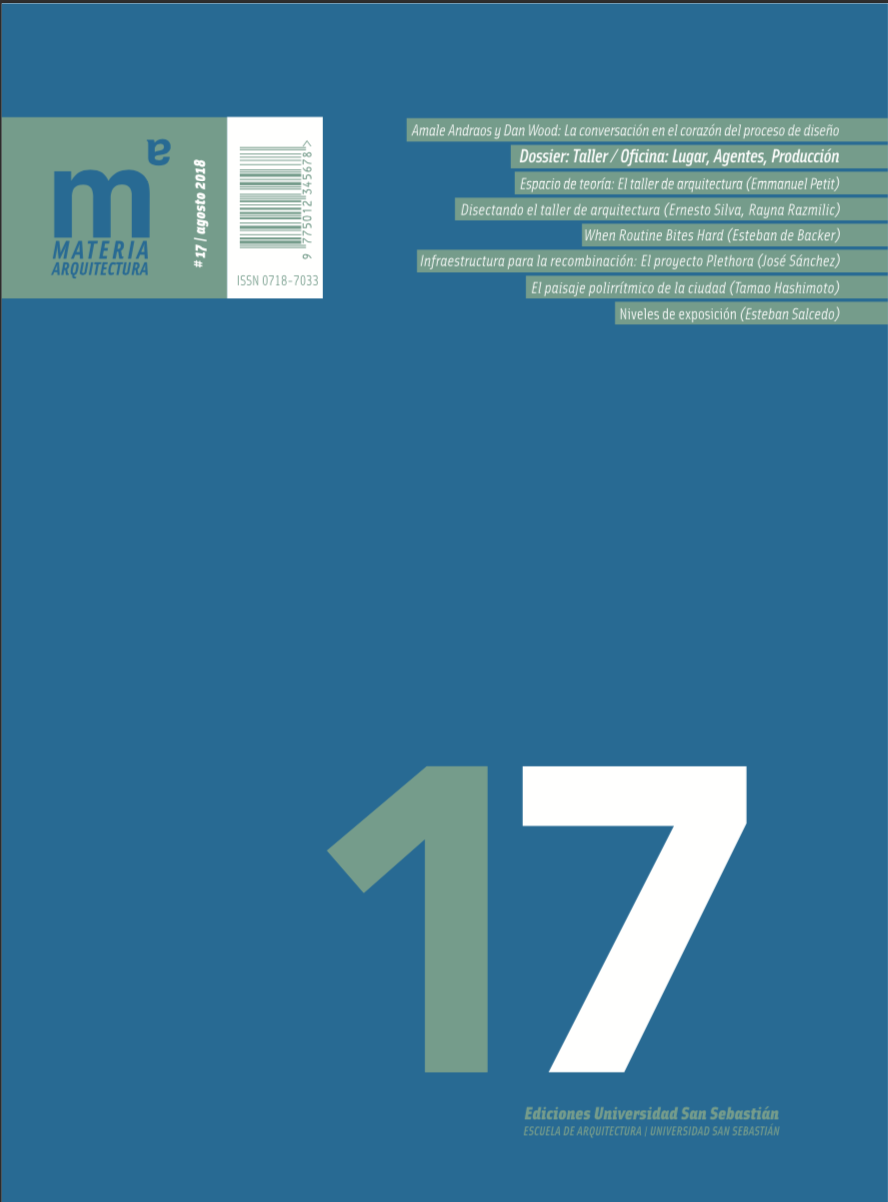Infrastructure for recombination: The work and ethos of Plethora Project
Barra lateral del artículo
Palabras clave:
Contenido principal del artículo
Resumen
This paper presents a critique to the traditional business model followed by many architecture studios who utilize the ‘architectural competition’ as a format for developing new ideas and innovation. The abundant competition calls, implying free labour, that architectural competitions facilitate has become a mechanism to coerce architectural innovation towards the benefit of a ruling elite. The Plethora Project studio has attempted since 2011 to hybridize the practice of architecture with forms of entertainment in order
to allow cultural engagement and ultimately communicate the challenges that architecture faces not only from a perspective of technological progress but from one of social progress as well. To do so, the medium of video games has been selected to communicate complex systems of interdependence, inviting a new audience of non- architects to participate in the construction of knowledge and discourse by understanding complex webs of interdependence that link material resources, knowledge, labour and
access. The studio sits at the intersection
between an architectural firm and a gaming studio with social interest. This implies the necessity for innovation in economic strategies that enable the autonomy of ideas and the development of non-conventional projects.
Detalles del artículo
Materia Arquitectura proporciona acceso inmediato y gratuito a todos los contenidos de esta edición electrónica, publicada simultáneamente con la edición impresa. Materia Arquitectura no cobra honorarios a los autores por ningún concepto.
Todos los contenidos de esta edición electrónica se distribuyen bajo licencia Creative Commons de “Atribución-Copartirigual 4.0 Internacional” (CC-BY-SA).
La licencia Creative Commons permite el acceso libre e inmediato al contenido y permite que cualquier usuario lea, descargue, copie, distribuya, imprima, busque o genere enlaces a los textos completos de los artículos, permitiendo también que estos puedan ser rastreados para indexarlos, pasarlos como datos a software o usarlos para cualquier otro propósito legal. Asimismo, la licencia otorga derechos de uso a quienes a su vez utilicen una licencia abierta (Creative Commons o equivalente).
Los derechos de los textos y las imágenes publicadas pertenecen a sus autores, quienes otorgan a Materia Arquitectura la licencia para su uso. La gestión de los permisos y la autorización de publicación de las imágenes (o de cualquier material) que contenga derechos de autor y sus consecuentes derechos de reproducción en esta publicación es de exclusiva responsabilidad de los autores de los artículos.
Toda vez que mencionen su origen, los autores son libres de distribuir sus artículos por otros medios. Cualquier reproducción total o parcial del material deberá citar su procedencia.
Descargas
Citas
BOGOST, I. (2006). Unit Operations: An Approach to Videogame Criticism. Cambridge, MA: MIT.
BRAYER, M.-A., & MIGAYROU, F. (2013). Naturalizing Architecture: Archilab 2013. Orleans, France: Editions HYX.
COOPER, S., TREUILLE, A., BARBERO, J., LEAVER-FAY, A., TUITE, K., KHATIB, F., ... POPOVIC, Z. (2010). The Challenge of Designing Scientific Discovery Games. In Proceedings of the Fifth International Conference on the Foundations of Digital Games (pp. 40–47). ACM.
GERSHENFELD, N. A., & WARD, J. D. (2016). US9506485B2. United States. Retrieved from https://patents.google.com/ patent/US9506485B2/en
LICKLIDER, J. C. R. (1960). Man-Computer Symbiosis. IRE Transactions on Human Factors in Electronics, HFE-1(1), 4–11. Doi: 10.1109/THFE2.1960.4503259
MAAS, W., GRAAFLAND, A., BATSTRA, B., VAN BILSEN, A., & PINILLA, C. (Eds.). (2007). Spacefighter: The Evolutionary City (Game:). Barcelona, Spain: Actar.
SÁNCHEZ, J., & ANDRASEK, A. (2017). BLOOM. In F. Gramazio, M. Kohler, & S. Langenberg (Eds.), Fabricate 2014 (pp. 98–103). London, England: UCL Press.
SCHOLZ, T., & SCHNEIDER, N. (2017). Ours to Hack and to Own: The Rise of Platform Cooperativism, a New Vision for the Future of Work and a Fairer Internet. New York, NY: OR Books.
SCHUMACHER, P. (2011). The Autopoiesis of Architecture: A New Framework for Architecture. Chichester, England: Wiley.
SRNICEK, N. (2016). Platform Capitalism. Cambridge, England: Polity Press.
Artículos más leídos del mismo autor/a
- Jose Sanchez, Simulación como re-enactamiento, la construcción de minga , Materia Arquitectura: Núm. 28 (2025): Materia Arquitectura 28 (Agosto/August 2025)
- José Sánchez, Infraestructura para la recombinación: el trabajo y el ethos del proyecto Plethora , Materia Arquitectura: Núm. 17 (2018): Materia Arquitectura 17 (Agosto/August 2018)
